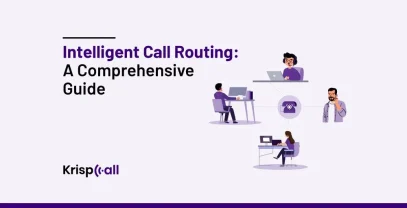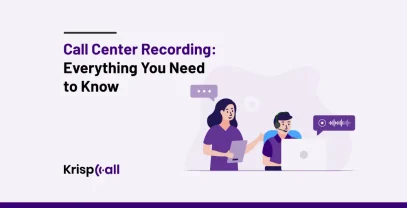A digital transformation considers your organization’s goals when adapting to new technology. But where does this fit into the context of contact centers?
A call center was once a room full of desks and headsets and crammed with agents. In the modern workplace, they are advanced communication hubs that allow agents to communicate with customers and other agents in a wide variety of ways, inside and outside the office environment.
Technology innovation is causing a rapid change in the contact center landscape. In 2024, businesses will place top priority on realigning their customer service experience. So it’s crucial to keep yourself abreast with the latest and top call center industry trends of 2024 and practice them in your contact centers.
But what are the notable call center trends of 2024? Let’s find that out in this article.
Top 10 Call Center Trends in 2024: New industry trends you need to follow
The call center industry has gone through numerous changes since the invention of technology and must constantly adapt to the changing needs of customers to remain competitive.
Companies that want to distinguish themselves from competitors must focus on this.
Contact centers must strike a balance between providing seamless digital experiences to customers while maintaining a personal touch in the face of the pandemic.
To offer a better customer experience, contact centers will have to be able to respond to changing client needs by using the best technologies and exploring empathy and attentiveness.
Here are the 10 contact center technology trends to expect in 2024.
1. Real-Time Transcription
Real-time transcription is one of the leading contact center trends where businesses are getting attracted to improve the ways of their customer experience and agent productivity. It uses the help of Artificial Intelligence (AI) to provide customer service agents with live transcriptions of customer conversations which helps to work & communicate in a better way.
In the contact center, this trend has become one of the popular features for all types of businesses. It can be used for various purposes including improving customer services and their interactions, for call center support, enhancing agent training, live captioning, and meeting transcription.

Even though it cannot replace human touch or natural speech, AI can gather as much information as possible from customer interactions. From an AI perspective, Google Dialogue flows can be used for agent engagement, services, and information delivery. Artificial intelligence is impacting the contact center in this way.
Real-time transcription isn’t just useful for improving customer satisfaction, however. The information contained within your transcripts can also inform factors such as website content, which is important for driving organic traffic through SEO. By analyzing your transcripts, you can identify common customer concerns and pain points and create keyword-rich content (how-to guides, ebooks, blog posts, etc.) addressing these.
2. Omnichannel Support
Omnichannel support is another one of the unmissable call center industry trends you need to follow in 2024.
Companies today are expected to respond to consumers across many different channels. There’s no doubt about that. The problem, however, is that when customers switch platforms, they detest repetition. For instance, when going from email support to phone support.
Omnichannel support becomes increasingly important to your call center’s success as consumers become more accustomed to communicating using a range of different methods.
Telephone assistance is more convenient for some customers. Email, text, or live chat are other types of text-based communication preferred by some.

A complex issue can sometimes make it difficult to resolve without video or screen sharing, regardless of consumer preference. Whatever the case, if you want to offer the best customer service there is, you have to be prepared to meet your audience where they are.
Omni-channel platforms are a must-have strategy for all contact centers gearing up for the future of digital communications, enabling voice, video, and chat communications through a single, universal platform that meets various call center needs, such as skill-based routing or customer care. In addition to enhancing workers’ efficiency, agents are also able to provide more personalized service to customers.
3. Enhanced Analytics
Data is informing business decisions more and more, and the trend is set to continue into 2024. Traditional hardware is generally less intelligent than cloud solutions. Data collected from these devices are potentially useful for identifying areas for improving customer experience.
Advanced contact center analytics are more viable and useful thanks to omnichannel call centers. When you take an omnichannel approach, you get a comprehensive view of all customer data and interactions, so the analytics you collect will be accurate.
Dashboards that feature key statistics about a call center are increasingly common in the contact center landscape. This trend is also driven by real-time analytics. Agents, for instance, should be able to view their average handling time and target performance in real time. The agent can adapt their approach in real-time if they can see which targets they are meeting and which ones need improving.
4. The Cloud
The adoption of cloud-based services is becoming more common. The majority of businesses used at least one cloud app in 2018, and more businesses are migrating to the cloud based contact centers. A move to the cloud can provide several benefits for call centers.
i. Scalability and Flexibility
Your growth is always limited by how much you can handle as a sole proprietor. The system will either have to be upgraded in hardware once it starts to become overloaded, or you will discover that your software is too slow. The cloud-based services are designed to be scalable to fit your business growth, so you don’t have to worry about that.
ii. Security and Maintenance
There are always new vulnerabilities discovered in software and hardware. All of these vulnerabilities must be managed manually if you don’t have a cloud-based service. Engineers are needed for this process, but it is expensive and inefficient to hire a team.
Maintaining your IT systems takes up a lot of time for your team, so you’re not getting the maximum benefit. By moving to a cloud-based model, they will have more time to focus on creative projects that will benefit their digital transformation efforts.
iii. Compliance
The latest IT best practices, regulations regarding data, and compliance guidelines are difficult to follow. There are frequent changes in compliance rules, so you may find that you are not in compliance without realizing it.
Using cloud-based services means you don’t have to worry about compliance since they have their own dedicated compliance teams.
5. Chatbots
It’s no secret that chatbots have gained popularity over the past few years, and this means they are on their way to becoming a necessity for businesses, as well as an expectation by consumers. And this call center industry trend is one of the indispensable ones in recent times.
The average customer prefers to deal with issues themselves whenever possible. Customers can use chatbots to review self-service solutions without needing the help of a customer service agent, which speeds up customer service.
Furthermore, a well-designed chatbot can be very effective at capturing details before a call occurs. Streamlining this process helps provide a better customer experience by making it easier to receive answers to questions or make a purchase.
Likewise, internal benefits can be realized. Chatbots are often able to answer simple questions just as thoroughly as humans.
6. Use of AI Technology
Businesses are significantly increasing customer satisfaction thanks to artificial intelligence. Employees working in contact centers are using AI techniques to identify client emotions and interpret unclear comments.
In this approach, the call center can provide top-notch customer support, shorten service wait times, and simplify the client experience.
Call centers are automating monotonous daily tasks with the aid of robotic process automation (RPA). When a contact center representative is on call, the RPA bots can respond to frequent customer questions, get pertinent customer data, direct customer complaints to the appropriate agent, and more.
To prevent agents from embarrassing themselves by sending the wrong emails to the clients, contact centers can also use AI to integrate recall technology.
This helps contact center representatives to immediately remove or change the transmitted messages if there is any typo or incorrect information.
7. Customized customer experience
Agents working in call centers will be able to examine client behavior based on past inquiries or service requests. You may use this information to precisely meet the demands of your clients and tailor their experiences.
Additionally, a customized client experience can significantly increase customer loyalty. Additionally, it improves customer experience KPIs like customer retention rate and customer satisfaction score.
More than 50% of customers believe that personalization significantly affects their purchasing decisions.
Surprisingly, automation can assist you in developing a customized consumer experience. Automating repetitive operations can improve agent effectiveness and give them more time to concentrate on one-on-one interactions with customers.
Additionally, it can assist agents in building client profiles with specific information about their interests.
8. Interactive Voice Response(IVR)
IVR systems have been more thoroughly integrated into call center operations as a result of recent technological advancements and the digital revolution.
IVR enables your consumers to interact with virtual voice messages to request information or choose to resolve a problem. The IVR system should presumably play a selection of automated menu items that the customer can select from.
The IVR can link the caller to your most knowledgeable agent for problem-solving if they need more assistance. Contact centers benefit from faster ticket service.
By combining IVR with AI, you may further improve their skills. Through advanced voice authentication, AI enables IVR systems to easily comprehend the caller’s intention.
9. Self-service tools
The new customer wants to make smart decisions and is perceptive and knowledgeable. Normally, they favor self-service resources like FAQ pages, community forums, real-time chats, and knowledge bases.
In 2024, this propensity has grown increasingly evident. To reduce the amount of human interaction, people have become used to self-service solutions.
Additionally, users can use an advanced self-service option to find the answer on their own instead of making phone calls to contact centers. These days customers want businesses to offer self-service options.
Instead of taking the agent’s time to understand their issue, it enables clients to locate the solutions themselves using tutorials and in-depth FAQs. This ultimately enhances the client experience.
10. Flexible working hours
Remote call center employees have been growing in popularity since the COVID-19 pandemic thanks to lower expenses, time zone portability, and flexible working schedules.
Remote workers have established themselves as a permanent component of the contact center environment thanks to continuously improved unified communications.
Call center agents can be mobile and have access to contact center service from any location without missing any key requirements.
The most popular working model in 2024 will continue to be hybrid working which gives agents the option to work from home or in an office.
What are the future of Call Center?
Current organization depends on call center software to cater to better customer service and experience. This contact center is well equipped with advanced features like call routing and recording, custom greeting, and global calling, and improves agent productivity allowing them to concentrate on their tasks.

Nowadays, it uses automation for handling tasks and can also integrate with different CRM software to provide agents access to customer data, and resolve their issues, or queries instantly. The various aspects that may vary in future call centers are:
1. Decrease in Cost
Call Center software can decrease costs by increasing first-call resolution rates, automating tasks, optimizing the level of staff, and outsourcing non-core functions, which helps boost customer satisfaction. It helps to generate various reports depending on the key performance metrics and provides future insights to help businesses make good decisions for improving work operations.
2. Adapting to New Technology
Due to the advancement in the Technology sector, a contact center must adapt to the new approaches and technologies in the coming days to provide better customer experience and satisfaction. It must include technologies like omnichannel communication, invest in AI automation, and invest in agent training. Call center employees must be able to learn and understand the new trends & technologies that help to improve their work in a better way.
3. Secure of User Data & Privacy
The major challenge for a call center is keeping their data secure and private. With the growing technology, there is a high risk of data breaches and privacy violations. The contact center must be fully prepared to secure the data of all its customers by using various data protection practices and encryption tools.
4. Change in Customer Preference & Needs
The contact center must be prepared to adapt according to the changing needs and preferences of a customer. In future call centers, most people are looking for features like omnichannel support, easy and fast resolution, personalized experience, self-option, and data privacy, etc. They want to use contact center software that provides their needs and demands, and that software that can evolve with their demand will rise in the future.
Top-notch Call Center Software With All The Trendy Features
With the technology constantly evolving, call centers also experience changes and incorporate new features. So such types of contact center trends can change with time. A good contact center software understands the users’ needs and incorporates new features that are best for businesses.
In that context, KrispCall is making quite a mark with its advanced cloud telephony and contact center services. It comes with a plethora of handy features to ensure a good customer experience and improved workspace efficiency.
In addition to the feature-packed services, KrispCall is negligibly cheap when it comes to price. The subscription packages are designed to fit businesses of all types and sizes and they are affordable at the same time.
To make things exciting, KrispCall is also offering a Free demo. So if you are using it for the first time, you can thoroughly use and navigate its features without spending a penny.





